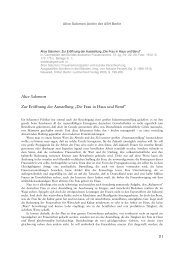Teaching Gender in Social Work - MailChimp
Teaching Gender in Social Work - MailChimp
Teaching Gender in Social Work - MailChimp
Create successful ePaper yourself
Turn your PDF publications into a flip-book with our unique Google optimized e-Paper software.
private and public, civil and political, emotional and rational, and so forth,<br />
where the first b<strong>in</strong>ary pole is said to belong to women and the other to men.<br />
This matrix of thought is susta<strong>in</strong>ed by disconnect<strong>in</strong>g the past, knowledge of<br />
which could assist us <strong>in</strong> transcend<strong>in</strong>g such b<strong>in</strong>ary th<strong>in</strong>k<strong>in</strong>g.<br />
The aim of the book is to focus on the teach<strong>in</strong>g of gender and social work<br />
<strong>in</strong> social work education. It will exam<strong>in</strong>e the methods and approaches used <strong>in</strong><br />
the teach<strong>in</strong>g of gender and history, demonstrat<strong>in</strong>g the use of teach<strong>in</strong>g material<br />
that <strong>in</strong>cludes gender. Further, it will focus on important issues that facilitate<br />
an understand<strong>in</strong>g of gender, <strong>in</strong>equalities and <strong>in</strong>justices and help us to reth<strong>in</strong>k<br />
the role of women <strong>in</strong> the establishment of the social work profession. The<br />
book is divided <strong>in</strong>to three parts. Articles <strong>in</strong> the first part relate to the teach<strong>in</strong>g<br />
process. They <strong>in</strong>clude methods, tools and new approaches to teach<strong>in</strong>g. They<br />
also reflect on the teach<strong>in</strong>g process and its implications for students’ understand<strong>in</strong>g<br />
of gender. Articles <strong>in</strong> the second part show how the past can be used<br />
to expla<strong>in</strong> the present. They refer to various historical developments with an<br />
impact on women and their position and role <strong>in</strong> social work. They also explore<br />
how gender <strong>in</strong> social work is constructed. An article compris<strong>in</strong>g the third part<br />
of the book is teach<strong>in</strong>g material itself; it presents a photo album from the Alice<br />
Salomon Archive <strong>in</strong> Berl<strong>in</strong> and tells the story of the beg<strong>in</strong>n<strong>in</strong>gs of social work<br />
<strong>in</strong> Germany.<br />
The first part of the book is entitled “Reflections on <strong>Teach<strong>in</strong>g</strong> and New<br />
Approaches”. Carol<strong>in</strong>e Skehill outl<strong>in</strong>es the way <strong>in</strong> which gender and social<br />
work has been taught <strong>in</strong> an <strong>in</strong>tegrative fashion. While referr<strong>in</strong>g to some of the<br />
major theories of fem<strong>in</strong>ism and gender perspectives, the primary aim of the<br />
article is to comment on the process and method of teach<strong>in</strong>g gender and social<br />
work. Mirja Satka and Johanna Moilanen explore a case of gender division <strong>in</strong><br />
F<strong>in</strong>nish public adm<strong>in</strong>istration, which can be traced back to the n<strong>in</strong>eteenth<br />
century and still exists almost unchanged. While the women directly <strong>in</strong>volved<br />
<strong>in</strong> provid<strong>in</strong>g services placed a primary value on care and concern for human<br />
well-be<strong>in</strong>g, the social welfare adm<strong>in</strong>istration run by men prioritised economics.<br />
The result is today’s welfare bureaucracy, <strong>in</strong> which control is exerted by men<br />
through a demand for economy and efficiency. Elena Iaskaia Smirnova and<br />
Pavel Romanov develop and adopt a method of us<strong>in</strong>g visual sources <strong>in</strong> social<br />
work education. Visual sources can be used to deconstruct the manner <strong>in</strong> which<br />
social problems have been def<strong>in</strong>ed throughout history and to demonstrate how<br />
such ideologies cont<strong>in</strong>ue to <strong>in</strong>fluence social work practices. Visual sources are<br />
12














